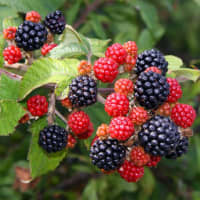The Blackberry is an edible soft fruit, consisting of a cluster of soft purple-black drupelets.
Healing Properties
Brain Health
Antioxidant
Free radical scavenging.[1]
Anti-Glycation
Glycation is associated with several neurodegenerative disorders, including Alzheimer’s disease (AD), where it potentiates the aggregation and toxicity of proteins such as β-amyloid (Aβ).[1:1]
Glycation is a process that interferes with the molecular and cellular functioning of the entire body. It involves the release of highly oxidizing side-products such as hydrogen peroxide. Damage by glycation results in stiffening of the collagen in the blood vessel walls, leading to high blood pressure, especially in diabetes.[1:2]
Glycations also cause weakening of the collagen in the blood vessel walls, which may lead to micro- or macro-aneurisms; this may cause strokes if in the brain.[1:3]
Parts of the body most at risk to the affects of glycation are: Long-lived cells (such as nerves and different types of brain cell), long-lasting proteins (Cells such as the retina cells in the eyes; crystallins of the lens and cornea), and DNA may accumulate substantial damage over time.[1:4]
Red blood cells have a consistent lifespan of 120 days and are easily accessible for measurement of glycation.[1:5]
Microglial Neuroprotective
Polyphenol & anthocyanin-enriched extracts of blackberry help protect the brain’s microglia (Microglia are a type of glial cell located throughout the brain and spinal cord. Microglia account for 10–15% of all cells found within the brain. Microglia act as the first and main form of active immune defense in the central nervous system).[1:6]
Disease / Symptom Treatment
Neurodegenerative Diseases
Alzheimer’s Disease
Title: Evaluation of Polyphenol Anthocyanin-Enriched Extracts… for Free Radical Scavenging, Reactive Carbonyl Species Trapping, Anti-Glycation, Anti-β-Amyloid Aggregation, and Microglial Neuroprotective Effects
Publication: International Journal of Moleculary Science
Date: Feb 2018
Study Type: Human Study: In Vitro
Author(s): Hang Ma, Shelby L. Johnson, Weixi Liu, Nicholas A. DaSilva, Susan Meschwitz, Joel A. Dain, and Navindra P. Seeram
Institution(s): Wuyi University, Guangdong, China; University of Rhode Island, Kingston, Rhode Island, USA; Salve Regina University, Newport, Rhode Island, USA
Copy: archive, archive-mirror ↩︎ ↩︎ ↩︎ ↩︎ ↩︎ ↩︎ ↩︎ ↩︎ ↩︎
